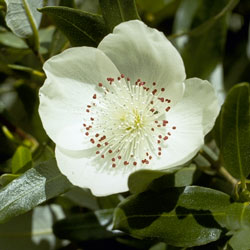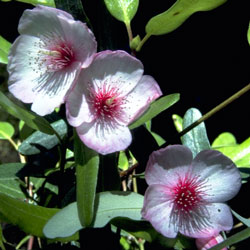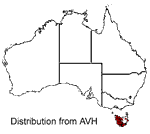Eucryphia lucida
 |
 Eucryphia lucida 'Ballerina' |
Leatherwood
Eucryphia lucida (Labill.) Baill.
Eucryphia lucida, or Leatherwood as it is commonly called, is a medium-sized tree with a compact crown of glossy green leaves. This cool temperate rainforest tree produces masses of white, showy flowers that have a honey scent. It is an endemic Tasmanian cool temperate rainforest tree that occurs in moss forests in the wetter areas of Tasmania's western side. It co-occurs with Myrtle Beech (Nothofagus cunninghamii), Southern Sassafras (Atherosperma moschatum) and Blackwood (Acacia melanoxylon).
 The genus Eucryphia is in the family Cunoniaceae, a southern hemisphere family of about 27 genera. There are about 8 species of Eucryphia in the world; five being in Australia. There are currently four cultivars of Eucryphia lucida: ‘Pink Cloud', a pale to medium pink flowered variety; ‘Ballerina' a pale pink flowered variety with deep pink stamens; ‘Leatherwood Cream' a variegated leaf variety and ‘Leatherwood Silver', a variety with silver edged leaves.
The genus Eucryphia is in the family Cunoniaceae, a southern hemisphere family of about 27 genera. There are about 8 species of Eucryphia in the world; five being in Australia. There are currently four cultivars of Eucryphia lucida: ‘Pink Cloud', a pale to medium pink flowered variety; ‘Ballerina' a pale pink flowered variety with deep pink stamens; ‘Leatherwood Cream' a variegated leaf variety and ‘Leatherwood Silver', a variety with silver edged leaves.
E. lucida is commonly a tree of 10-15 m but can reach heights of 30 m in its natural habitat. It has dark green to grey-brown, smooth bark, which is often covered with lichens. The leaves are simple, opposite, oblong, about 2-4 cm long, dark green above, and white below; the new leaves are glossy. E. lucida flowers are rose-like with 4 white petals and numerous showy stamens. The sepals are joined at the apex to form an operculum when the flower is in bud, and this operculum is shed as the petals expand. The fruits are small, leathery capsules which, when ripe, release many coppery-winged seeds about 12 months after flowering.
Leatherwood's plentiful flowers produce copious amounts of nectar that is favoured by bees. The honey thus produced is the famous Leatherwood honey that is well known and enjoyed by many in Tasmania. E. lucida also produces a fine timber.
E. lucida can grow in semi-shade or full sun, but prefers a sheltered position from wind. It is also quite frost tolerant. E. lucida does best in well drained, acid and neutral soils of low to intermediate fertility.
E. lucida propagates easily from seed or cuttings. The cultivars must be propagated from cuttings. The best propagation medium is one with good moisture holding properties and adequate drainage. The seed should be stored in cool, dry conditions until needed and when planted should germinate readily in around two weeks. For cuttings, half-ripe wood, 6-8 cm in length should be used. A rooting hormone can be used for better results.
Leatherwood makes a great tub plant and can be pruned to keep it in a compact shape. When established E. lucida should require less water and can be pruned after each flowering season to keep it as a compact, bushy shrub that will produce more flowers in the next flowering season.
Text by Amber Grimley (2005 Student Botanical Intern)
Derivation of the name: Eucryphia lucidaEucryphia – from the Greek words ‘eu', meaning well, thoroughly, and kryphios , meaning hidden, cover, referring to the sepals which are joined at the apex of the buds. lucida – from the Latin word lucidus, meaning shiny, clear, in reference to the shiny leaves. Leatherwood - probably in reference to the toughness of the timber. |
![An Australian Government Initiative [logo]](/images/austgovt_brown_90px.gif)

